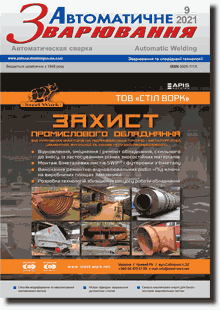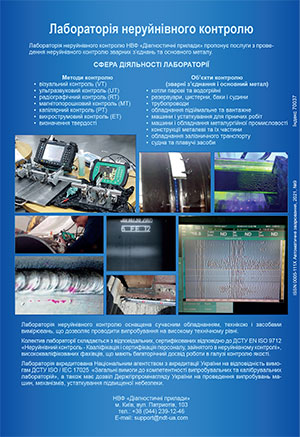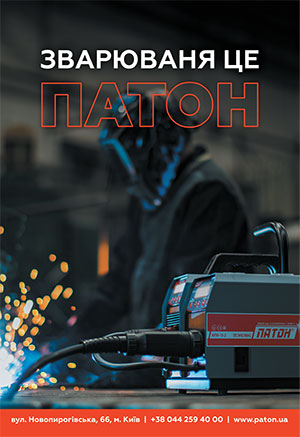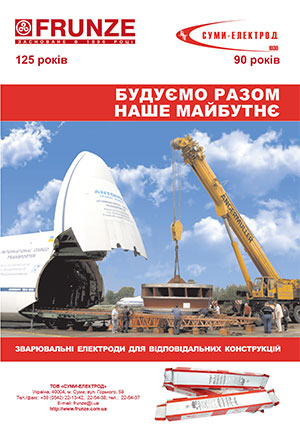| 2021 №09 (08) |
DOI of Article 10.37434/as2021.09.01 |
2021 №09 (02) |

"Avtomatychne Zvaryuvannya" (Automatic Welding), #9, 2021, pp. 3-11
Classification of methods of modification and microalloying of deposited metal (Review)
A.A. Babinets, I.O. Ryabtsev
E.O. Paton Electric Welding Institute. 11 Kazymyr Malevych Str., 03150 Kyiv, Ukraine. E-mail: office@paton.kiev.ua
A literature review of the main methods of modification and microalloying of deposited metal was made. It was shown that, in contrast to the term «microalloying», the term «modification» should consider not only a method of introducing small additives of chemical elements or their compounds into the deposited metal but also various physical effects or technological processes aimed at achieving the same goal – refinement of micro- and macrostructure of metal, cleaning of grain boundaries and boundary zones, improving the complex of technological, mechanical and operational properties of steels and alloys. Examples of such physical effects are application of vibrations to a product in the process of surfacing; input of power from a pulsed heat source; pulsed electrode or filler wire feed; application of sources with modulation of welding current; external electromagnetic effect, etc. The classification of modification methods depending on the scheme of their implementation and impact on the properties of the deposited metal is given. The main advantages and disadvantages of methods of introducing modifying and microalloying additives into the deposited metal are shown. It was determined that from the considered methods of modification, the chemical method is the simplest and the most rational, which implies introducing modifier elements into the deposited metal directly through the charge of flux-cored electrode wires. This method is technologically and economically simple and versatile, and can be used with minor changes in electric arc, electroslag and plasma surfacing. 33 Ref., 1 Tabl., 3 Fig.
Keywords: arc surfacing, deposited metal, flux-cored wire, modification, microalloying, metal structure, service properties
Received: 21.07.2021
References
1. Manyak, N.A., Manyak, L.K. (2002) Influence of boron on structure and toughness of low-alloy steel. Metall i Lityo Ukrainy, 5-6, 23-25 [in Russian].2. Lyakishev, N.P. (2000) Thesaurus on metallurgy. Moscow, Intermet Engineering [in Russian].
3. Bublikov, V.B. (2008) High-strength cast iron - 60 (Review). Litejnoe Proizvodstvo, 11, 2-8 [in Russian].
4. Goldshtejn, Ya.E., Mizin, V.G. (1986) Modification and microalloying of cast iron and steel. Moscow, Metallurgiya [in Russian].
5. Zadiranov, A.N., Kats, A.M. (2008) Theoretical principles of crystallization of metals and alloys. Moscow, MGIU [in Russian].
6. Boldyrev, A.M., Grigorash, V.V. (2011) Problems of microand nanomodification of welds in welding of building metal structures. Nanotekhnologii v Stroitelstve, 3(3), 42-52 [in Russian].
7. Zubenko, L.N. (2015) Applicaion of modifiers in composition of functional coatings. Tekhnologii i Materialy, 2, 20-23 [in Russian].
8. Sheksheev, M.A., Mikhailitsyn, S.V., Sychkov, A.B. et al. (2018) Examination of influence of ultradisperse particles of tungsten monocarbide on structure of deposited metal. VestnikYuzhno- Uralsky Gos. Un-ta, Series: Metallurgiya, 18(4), 128-136 [in Russian]. https://doi.org/10.14529/met180414
9. Pulka, Ch.V., Shably, O.N., Senchishin, V.S., Sharyk, M.V., Gordan, G.N. (2012) Influence of vibration of parts on structure and properties of metal in surfacing. The Paton Welding J., 1, 23-25.
10. Lashchenko, G.I. (2016) Technological capabilities of vibration treatment of welded structures (Review). Ibid., 7, 26-31. https://doi.org/10.15407/tpwj2016.07.05
11. Razmyshlyaev, A.D., Ageeva, M.V. (2018) On mechanism of weld metal structure refinement in arc welding under action of magnetic fields (Review). Ibid., 3, 25-28. https://doi.org/10.15407/tpwj2018.03.05
12. Razmyshlyaev, A.D., Ageeva, M.V., Lavrova, E.V. (2019) Refinement of metal structure in arc surfacing under the effect of longitudinal magnetic field. Ibid., 2, 19-21. https://doi.org/10.15407/tpwj2019.02.02
13. Ryabtsev, I.A., Kuskov, Yu.M., Pereplyotchikov, E.F., Babinets, A.A. (2021) Surfacing. Control of base metal penetration and formation of deposited layers. Ed. by I.A.Ryabtsev. Kiev, Interservice [in Russian].
14. Kirian, V.I., Kajdalov, A.A., Novikova, D.P., Bogajchuk, I.L., Kesners, M. (2007) Improvement of welded joint structure under the impact of wideband ultrasonic vibrations during welding. The Paton Welding J., 2, 38-40.
15. Morozov, V.P. (2006) Peculiarities of process of primary structures formation of welds of different system aluminium alloys. Izv. Vuzov, Mashinostroenie, 9, 51-64 [in Russian].
16. Antonov, A.A., Artemiev, A.A., Sokolov, G.N. et al. (2016) Development of method of consumable electrode arc surfacing with filler wire. Sovremennye Problemy Teorii Mashin, 4(2), 99-101 [in Russian].
17. Boldyrev, A.M., Orlov, A.S., Gushchin, D.A. (2016) New technology for producing of granulated filler material with nanomodifying additives for arc welding of steels. Nanotekhnologii v Stroitelstve, 8(6), 124-143 [in Russian]. https://doi.org/10.15828/2075-8545-2016-8-6-124-143
18. Gladky, P.V., Mikaelyan, G.S. (2015) Microalloying and modification of wear-resistant deposited metal. In: Surfacing. Technologies, materials, equipment. Kiev, PWI [in Russian].
19. Zusin, V.Ya. (2011) Investigation of modification of metal deposited by flux-cored wire with aluminium sheath. Vestnik Priazov. GTU. Series: Tekhnicheskie Nauki, 23, 180-183 [in Russian].
20. Shlepakov, V.N., Gavrilyuk, Yu.A., Naumejko, S.M. (2011) Development of flux-cored wire for arc welding of highstrength steel of bainite class. The Paton Welding J., 11, 15-18.
21. Fejnberg, L.I., Rybakov, A.A., Alimov, A.N., Rosert, R. (2007) Weld microalloying with titanuim and boron in multiarc welding of large diameter gas and oil pipes. Ibid., 5, 12-16.
22. Litvinenko-Arkov, V.B., Sokolov, G.N., Kyazymov, F.A. (2012) Structure and properties of heat-resistant metal, deposited by flux-cored wires with TiCN nanoparticles. Izv. Volgograd GTU, 9, 194-197 [in Russian].
23. Makarov, A.V., Kudryashov, A.E., Vladimirov, A.A., Titova, A.P. (2019) Application of deposited materials modifying with refractory components for restoration of rollers of billet continuous-casting machines. Vestnik Bryansk GTU, 8, 41- 48 [in Russian]. https://doi.org/10.30987/article_5d6cbe428ab026.77335497
24. Golovko, V.V. (2018) Possibilities of nanomodification of dendrite structure of weld metal. The Paton Welding J., 8, 2-6. https://doi.org/10.15407/tpwj2018.08.01
25. Sokolov, G.N., Zorin, I.V., Artemiev, A.A. et al. (2014) Peculiarities of formation of structure and properties of deposited alloys under influence of refractory compound nanoparticles. Fizika i Khimiya Obrabotki Materialov, 2, 38-47 [in Russian].
26. Sokolov, G.N., Artemiev, A.A., Dubtsov, Yu.N. et al. (2018) Influence of nitrogen and titanium carbonitride particles on structure and properties of Fe-C-Cr-Ni-Mo system metal deposited by flux-cored wire. Omskij Nauchnyi Vestnik, 2, 15- 19 [in Russian]. https://doi.org/10.25206/1813-8225-2018-158-15-19
27. Yakovlev, D.S., Shakhmatov, M.V. (2015) Microalloying of welded joints by flux-cored wire. Tekhnologii i Materialy, 2, 23-28 [in Russian].
28. Yakushin, B.F., Potapov, S.V., Kilyov, V.S. (2015) About direct modification of welding pool in submerged-arc welding. ESU, 12-5, 126-133 [in Russian].
29. Babu, N., Talari, M., Pan, D., Sun, Z., Wei, J., Sivaprasad, K. (2012) Microstructural characterization and grain refinement of AA6082 gas tungsten arc welds by scandium modified fillers. Materials Сhemistry and Physics, 137/2, 543-551. https://doi.org/10.1016/j.matchemphys.2012.09.056
30. Kuznetsov, V.D., Stepanov, D.V. (2015) Structure and properties of weld metal modified by nanooxides. The Paton Welding J., 11, 10-16. https://doi.org/10.15407/tpwj2015.11.01
31. Alyoshin, N.P., Grigorieva, M.V., Kobernik, N.V. et al. (2018) Modification of weld metal with tungsten carbide nanosized particles in twin-arc submerged-arc welding. Khimiya Vysokikh Energij, 52(5), 426-431 [in Russian]. https://doi.org/10.1134/S0018143918050028
32. Peremitko, V.V. (2014) Wear-resistant arc surfacing over the layer of alloying charge. The Paton Welding J., 8, 54-57. https://doi.org/10.15407/tpwj2014.08.09
33. Peremitko, V.V., Nosov, D.G. (2015) Optimization of modes of submerged arc surfacing over the layer of alloying charge of caterpillar machine running gear parts. Ibid., https://doi.org/10.15407/tpwj2015.06.10




